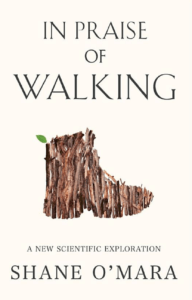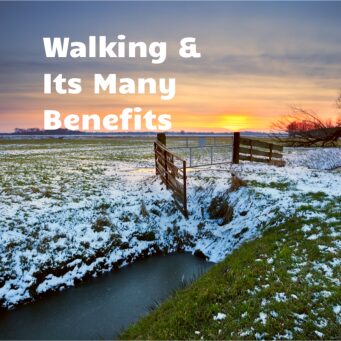Walking and its many benefits
 Taylor Downing inspired by Shane O’Mara’s book, In Praise of Walking, explores walking and its many benefits in this article. It is rare not to see this keen walker come-author, historian and editor of THE ROUSDONER, pounding the local lanes. I was delighted when he agreed to let me share his January 2021 article. Taylor contrasts his own experience with some essential scientific facts from O’Mara’s book. Clearly, like many of us he has had time to think and enjoy the beautiful surrounds of our lovely county. It comes at a time when the nation went back into lockdown, as it had been back in March 2020. Doubtless we must turn our minds again to exercise and the benefit that walking brings us, albeit in the cooler climate of Winter. EDITOR
Taylor Downing inspired by Shane O’Mara’s book, In Praise of Walking, explores walking and its many benefits in this article. It is rare not to see this keen walker come-author, historian and editor of THE ROUSDONER, pounding the local lanes. I was delighted when he agreed to let me share his January 2021 article. Taylor contrasts his own experience with some essential scientific facts from O’Mara’s book. Clearly, like many of us he has had time to think and enjoy the beautiful surrounds of our lovely county. It comes at a time when the nation went back into lockdown, as it had been back in March 2020. Doubtless we must turn our minds again to exercise and the benefit that walking brings us, albeit in the cooler climate of Winter. EDITOR
Note: ‘The Rousdoner’ is an independent private magazine supported by the local community

Taylor Downing photo by Hopkinson
Many in my local community enjoy walking

Shane O’Mara’s Book In praise of Walking as shown on Amazon (2020)
During 2020 and the many months of lockdown and near-lockdown, going for a walk has been a real tonic to me, and to many others. Walking from our village along the near-empty country lanes and winding footpaths of East Devon has been a great boost and all the clichés are true about feeling closer to nature and more sensitive to the changing seasons than I would have been in London, or any other city. I was fascinated to read a book recently that takes this a stage further. Shane O’Mara is Professor of Experimental Brain Research at Trinity College, Dublin and a leading international neuro-scientist. And he is an enthusiastic walker. But O’Mara doesn’t stop at the assertion that walking is good for our bodies and our minds, making us healthier, happier and brainier. He assembles the data to prove it. In Praise of Walking is a fascinating read and very accessible.
Bipedalism
O’Mara begins by arguing that one of the things that makes us uniquely human is the ability to stand upright and walk on our two feet, known as ‘bi-pedalism’. This frees our hands for other things, for instance, carrying food, holding a weapon or carrying children. By shifting locomotion to our feet and stabilising our balance along the spine and hips, with a more or less vertical spinal column, humans have been able to attack others with spears or axes, or gather and transport food, or carry our young over long distances. Walking upright also makes our minds mobile and we can think, plan and observe as we move about.
It was this ability that enabled early human beings to walk out of Africa, where our race began, and to populate all the continents of the world. Homo sapiens appears to have moved out of East Africa about 60,000 years ago. Although humans are neither particularly fast walkers or runners and can be outrun by many species, we are able to cover long distances on foot. No doubt the first migrations were by groups of humans who travelled thousands of miles over time. So the migrations were a social or collective experience. Thus the African proverb ‘If you want to go fast, go alone. If you want to go far, go together.’
Walking helps our brain develop
 O’Mara goes on to show that walking and movement is an essential part of building our knowledge of the world. This starts as toddlers walking around the home, discovering what is where and learning not to fall. Walking is the product of a collaboration between top down control of the brain, bottom-up input from the feet and legs, and a mid-level rhythmical control based in the spinal cord. It is now understood that movement uses several different parts of the brain. One’s spatial awareness system corresponds to parts of the thalamus. Recent research has shown that regular aerobic exercise like walking can actually produce new cells in the hippocampus, the part of the brain that supports learning and memory. Many of us are concerned about losing what we loosely call memory cells as we get older. Research suggest that walking can help at least to slow this down. Walking is a good, simple and natural form of exercise that requires nothing but a pair of decent shoes.
O’Mara goes on to show that walking and movement is an essential part of building our knowledge of the world. This starts as toddlers walking around the home, discovering what is where and learning not to fall. Walking is the product of a collaboration between top down control of the brain, bottom-up input from the feet and legs, and a mid-level rhythmical control based in the spinal cord. It is now understood that movement uses several different parts of the brain. One’s spatial awareness system corresponds to parts of the thalamus. Recent research has shown that regular aerobic exercise like walking can actually produce new cells in the hippocampus, the part of the brain that supports learning and memory. Many of us are concerned about losing what we loosely call memory cells as we get older. Research suggest that walking can help at least to slow this down. Walking is a good, simple and natural form of exercise that requires nothing but a pair of decent shoes.
Too much sedentary life…
O’Mara quotes recent research in America that shows that people spend 87% of their time in the artificial environment of offices, houses, shops and cars. Much of this time is spent sitting, with the weight of our body trunk largely concentrated on the lower back. A sedentary life is largely unhealthy leading to a decline in muscle volume and strength, without activating the positive effects of exercise on the brain. However, time spent in nature nearly always makes us feel better and creates a sense of well-being. Regular exposure to nature, and this includes visiting the countryside or walking by the sea, has a measurable effect on improving human health and welfare. O’Mara has a chapter on how walking is conducive to thinking creatively and to solving problems. And he has a chapter on how walking is a social experience that helps to bring us together, whether on a family walk, to play golf with friends, or to join a protest march to bring change. One recent study has shown that elderly people who walk for about 150 mins a week feel a sense of better overall well-being than those who are less active.
The message is simple: Walking is Good

Personally, I don’t walk to be creative nor I do think it makes me any more social. But as with all other forms of aerobic exercise like running, cycling or swimming, I know it helps my physical health and mental welfare. The core takeaway from the book is that it really is beneficial to get out and to walk regularly in the course of the day, and to do this every day. Walking the dog is good, walking to the shops or office is good, walking in the countryside is good, and for city- dwellers walking in a park is good. Regular walking can forestall many of the bad things that come from ageing. It is also associated with a heightening of creativity and an improved mood. It really can help your physical and mental health. Walking regularly will repay you in more ways than you realise. I already enjoyed regular walking but I’m very glad I read this book!
LOCAL WALKS
The Editor writes

Editor walking in the Lakes in September 2020
As Taylor points out to his local readers, “we have a myriad of footpaths to explore across our countryside”. The Coronavirus SARS episode has done much to awaken our awareness of our previous freedom. Walking offers a respite from the worries of a nation and world at war. Former paths, unknown in our countryside, are opening up and with some public byways previously obscured from walking are being contested. The right to walk is something we should all be able to enjoy. There are organisations such as Ramblers who provide constructive advice and guidance if you want to take matters to a new level. Local groups get together, when social gatherings are allowed, to organise walks together. Nordic walking is something my wife has found a great benefit combining activity with company when she is not out walking with me. Where to walk in Britain is covered by sites such as ‘Walking Britain‘. Julia Bradbury has contributed to making the walking scene exciting. Her passion on the screen is always fun to watch, but she is not alone as many other celebrities have joined in this popular pastime from coast to coast. Everyone has their take on walking and where to walk. Look out for the BBC series on Winter walks.
A bit of safety in mind
 When it comes to safety and what to wear there are plenty of helpful sites. Even ConsultingFootPain has put walking onto its site as one of the benefits of health but also from the viewpoint of avoiding known risks; from firewalking to the ankle’s role in walking.
When it comes to safety and what to wear there are plenty of helpful sites. Even ConsultingFootPain has put walking onto its site as one of the benefits of health but also from the viewpoint of avoiding known risks; from firewalking to the ankle’s role in walking.
Donald Rumsfeld (2002) suggested, “there are known knowns; there are things we know we know. We also know there are known unknowns; that is to say we know there are some things we do not know. But there are also unknown unknowns—the ones we don’t know we don’t know.”
When it comes to walking it is best to stick to the known knowns and prepare for the unknowns. Read my latest article on ankle sprains… Treating Simple Ankle Sprains
Thanks for reading “Walking and Its Many Benefits” by Taylor Downing reproduced with kind permission for ConsultingFootPain Footlocker Newsfeed

Published by Busypencilcase Reflective Communication Est. 2015

Why not sign-up and stay in touch with regular articles from ConsultingFootPain

Recent Comments